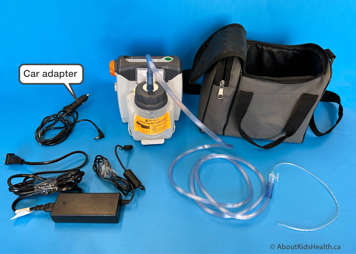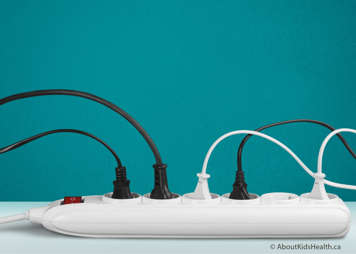At the end of this chapter, you will be able to:
- discuss strategies to prepare for long-term power failure
Many of the routine procedures that need to be performed when a child has a tracheostomy rely on a steady supply of power. It is important to be prepared in case of a long-term power failure (a power failure for more than six hours) so that you can minimize any disruptions to your child's care.
It is important to have an emergency plan and supplies prepared in advance.
- Flashlight (most cell phones have them now)
- Emergency tracheostomy kit
- Back up batteries
- Car adaptors:
- Some suction machines (e.g., Devilbiss Vacuaide) have 12 V DC capability for vehicle charging.
- Backup generators:
- A backup generator sits outside the home. It is wired into the home so it can detect a power outage. When the power goes out, it delivers power back to the home instantly.
- If you live in an apartment or condominium, there are portable backup generators available. Speak with building management or the condominium board if you are permitted to have a backup generator.
- Ensure you know how to use the backup generator safely.
- If you choose to purchase a generator, we advise that you educate yourself on this before using it. Refer to the user manuals on how it functions and safety considerations.
- Feeding pump car adaptors
- Feeding pumps vary in the amount of internal battery they have. Some go as long as 24 hrs.
- Car adaptors are available for many different brands of feeding pumps.

Electricity tripping in home/blackouts/rolling blackouts/brownouts:

- Ensure medical equipment is split up when plugged in, meaning you are plugging equipment into different AC outlets and not just all in one outlet or power bar.
- Ensure you have a good quality (functioning, not damaged) power bar. However, not all equipment can be plugged into the power bar. The equipment that cannot be plugged into the power bar and must be plugged directly into AC power includes:
- ventilators
- suction machines
- oximeter
Backup options:
- Suction machine
- Ensure you have manual suction setup in the emergency tracheostomy kit.
- Oxygen concentrator
- Ensure back up compressed air tanks are full.
- Oximeter
- Internal battery should be charged in case power goes out.
- Humidification
- Maintain humidification and hydration.
- Continue to keep water in the humidifier chamber (for children on ventilation).
- Ventilator
- Please see the chapter for ventilator battery specific information and ensure the manual resuscitation bag is on hand.
- Feeding pump – (link resources)
- Power wheelchairs
- Refer to your child’s wheelchair resources.
Plan how you can leave your home quickly.
Make a plan for how your family can get out of your home if there is a power failure or any other type of emergency. Getting out of your home quickly and safely can be difficult, for example if you live in a high-rise apartment building where a power failure interferes with the elevators.
Have a contact list on hand
Have a list of family and friends who live in your area. Make sure at least one person on your contact list lives nearby and understands your needs.
If there is a power failure, call your contact list to see if their power is out. If they still have power, you can go to their home.
Know where you can access a steady power supply
Research a place that will have a steady supply of power even during a long-term power failure and plan how you will get there. It could be a hospital, a hotel, a fire station or an ambulance hall near your home.
Contact your utility company
Many companies keep a ‘priority reconnection service’ list and map of the locations of power-dependent customers for use in an emergency. Note that even if you are on the list, it is possible that power could still be out for several days, access to back up power is important.